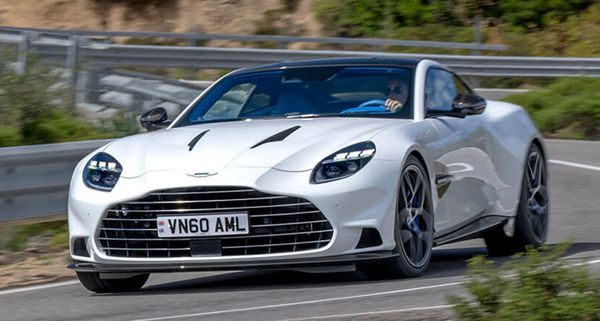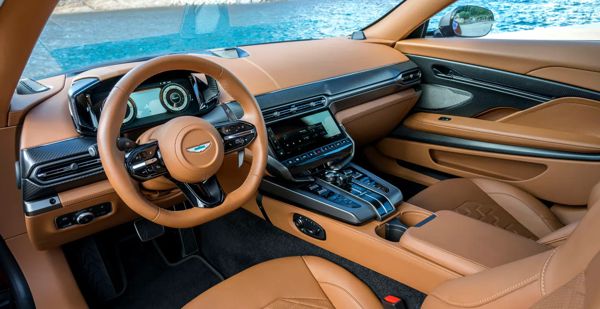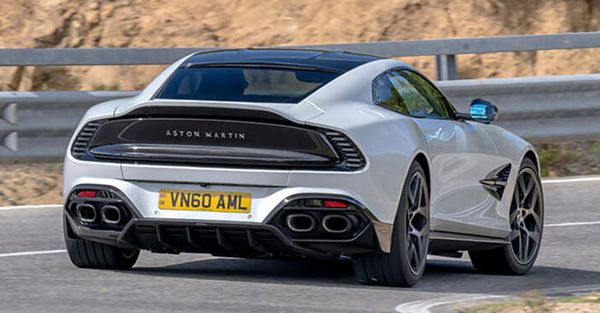| Published
on 21
Feb
2025 |
All rights reserved.
|
|
|

|
|
With
835 horsepower, Aston finally has something to challenge Ferrari's V12
model.
|
|
This is the latest
generation of Aston Martin's flagship GT, succeeding the Vanquish I
(2001), Vanquish II (2012) and DBS Superleggera (2018). Compared with
the outgoing final edition DBS 770 Ultimate, power and performance have
been lifted further, so is its pricing - now up to £333,000,
matching its arch-rival Ferrari 12Cilindri.
The new Vanquish is still unmistakably an Aston Martin, but its design
language evolves further to set it apart from its predecessors or other
Aston Martins. The key new feature is a Kamm tail with integral rear
spoiler and a rear quarter window with its trailing corner cut.
Triangular vents aft of the front wheels also differentiate it from
before. Up front, it is more familiar. The massive grille gets even
larger, i.e. 14 percent larger than that of the DBS 770 Ultimate. In
fact, it is so large that I doubt if there is any space for further
expansion.
The car is larger as well. 4850mm long and 2885mm in wheelbase, making
it 138mm and 80mm longer respectively than its predecessor. That's huge
for a strictly 2-seater! It weighs more, too, tipping the scale at 1774
kg without fluid, making it 65 kg heavier than the DBS 770, probably
200 more
than Ferrari, even though it employs full carbon-fiber body.
Fortunately, weight is well distributed between both axles, i.e. 51:49,
thanks to keeping transaxle layout.

|
|
It
roars angrily at wide open throttle, significantly louder and madder
than 12Cilindri even with turbochargers...
|
|
Like other Astons, the chassis is constructed of extruded
and bonded aluminum frames. Strengthening around the engine, suspension
mountings and underbody yields a 75-percent increase of lateral
stiffness, providing a stronger base for the new Bilstein DTX adaptive
dampers (from DB12) and thicker anti-roll bars to work on. Standard
carbon-ceramic brakes keep unsprung weight low while signifies the
car's flagship status. To handle increased power, wider tires are
fitted: 275/35ZR21 up front and 325/30ZR21 at the rear. These Pirelli P
Zero PZ4 rubbers employ bespoke compounds.
What separates the flagship GT from lesser Aston models is the
powertrain. Instead of AMG-sourced V8, it keeps using the "Cologne" V12
motor which debuted on DB7 Vantage back in 1999. The latest version
remains a twin-turbo 5.2-liter unit, but most parts have been modified,
such as a strengthened block and con-rods, new cylinder heads with
CNC-machined combustion chambers and modified ports, repositioned spark
plugs, new cam profiles, higher flowing injection and a 50% larger oil
cooler. Moreover, the new turbochargers feature lower inertia turbines
so that they can spin 15 percent faster and have quicker response. New
"Boost Reserve" function controls throttle and wastegate to keep boost
pressure high during momentary part-throttle, so that full boost can be
attained immediately when full throttle is applied again.
As a result, the V12 motor produces 835 horsepower at 6500 rpm and 737
pound-foot of torque at 2500-5000 rpm, 65 hp and 73 lbft more than its
predecessor. It also pips its Ferrari rival by 5 ponies and overwhelms
in torque output. The motor is now built by Autocraft Solutions in
England, as Ford closed its Cologne plant in 2021.

|
|
Aston
Martin's interior design looks bland and unimaginative.
|
|
The new V12 complies with Euro 6e emission standard and noise
regulations so that its future is guaranteed until 2030. As
electrification is proved to be uninteresting to exotic car buyers
lately, Aston's U-turn on hybridization and re-investing into the V12
motor seems to be a wise move.
As the final drive ratio is optimized for top speed rather than
acceleration, the new Vanquish's 0-60 mph sprint is improved by just a
tenth of a second to 3.2, but its terminal speed is lifted to 214 mph,
a new height for the company's production cars.
The ZF automatic transaxle partners with an electronic differential for
the first time. As the latter's control system is linked to ESP and
ABS, expect the car to display much improved handling at the limit.
Inside, there is not much drama. Although the leather upholstery feels
expensive enough and there are plenty of carbon-fiber, Aston Martin's
interior design looks bland and unimaginative. The digital instrument
looks ordinary, while Aston's home-grown infotainment system is far
from the best. Fortunately, there are plenty of physical switchgears to
by-pass the touchscreen. A standard panoramic glass roof gifts the
cabin an airy ambience.

|
|
Not
as good as Ferrari, but guarantees a more memorable driving experience.
|
|
On the road, the Vanquish amazes with its brawny V12. It
roars angrily at wide open throttle, significantly louder and madder
than the 12Cilindri even with turbochargers, surprisingly. It feels
more brutal, more forceful,
too, thanks to superior torque. Acceleration is actually slower, partly
down to inferior traction, partly the less responsive automatic
transmission, but you will swear
it was the faster car.
Despite the tremendous torque, the Vanquish is never short of traction
or roadholding. Its suspension is
quite firm at lower speed, but gets more composed when extended. It
balances well in corner and controls its weight tidily. Sure, it is not
as agile or as tightly controlled as the Ferrari due to its extra
weight and lack of rear-wheel steering, so you are more aware of its
size on tighter roads. Dive into fast corner, it takes a while to
settle on its springs and then fire out of corner exit. The brakes are
not as strong or
as sharp as Ferrari's, too, and the gearbox is no match for Ferrari’s
dual-clutch. However, the Aston’s steering feels more natural in
response and weighting. The engine has enough brutal power to overwhelm
the grippy rear tires at anywhere, any gears. It delivers just enough
fearsome character to
thrill and impress you, but not to the extent of frightening. In short,
it is not as good as the Ferrari, but
it guarantees a more memorable driving experience.
As a GT, the Aston is actually less agreeable than the Ferrari, as you
are drowned in more engine and road noises, and the suspension is
generally stiffer. You might argue that DB12 serves the role of GT
better, as it is shorter, lighter yet offers rear seats (or extra
luggage space). The DB12 is also significantly cheaper. However, as far
as a 2-seat flagship GT is concerned, Vanquish has not much competition
other than the Ferrari. Aston will be happy to build 1,000 cars a year,
which should not be too hard to achieve considering how good it feels
to drive.
|
Verdict:      |
|